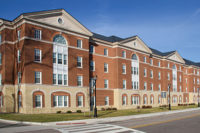When Walls & Ceilings found out that this year’s INTEX Expo would be held in North Carolina’s largest city, the magazine asked Charlotte-based National Gypsum if the company would collect several contractors into one gathering and conduct a roundtable. This opportunity would allow the gypsum manufacturer and the magazine’s readers a chance to discuss some of their respective successes, niche markets and issues they face in today’s challenging business climate.
National Gypsum’s Steve Cusa, gypsum product manager, was the event moderator, along with the magazine’s editor, in this roundtable discussion.
Fortunately, a handful of contractors were able to commit to the project that took place on April 17. Drywall (and other wall and ceiling industry related) contractors gathered at National Gypsum’s Mt. Holly plant to share with us their triumphs and concerns.
|
MT. HOLLY FACILITY |
|
The day began with a tour of National Gypsum’s newest gypsum board production plant in Mt. Holly, a short distance from uptown Charlotte. This state-of-the-art facility produces gypsum board in one of the industry’s most responsible manufacturing operations. The tour was lead by the company’s Director of Manufacturing Process Improvement, John Yakowenko. Mt. Holly is a high-speed plant capable of producing over 500 feet of gypsum board per minute. All paper used to make Mt. Holly gypsum board is produced by one of National Gypsum’s three paper mills, made from 100 percent recycled stock. |
The day began with a tour of the Mt. Holly facility, a state-of-the-art plant that produces 100 percent synthetic gypsum (see sidebar).
At the roundtable, contractors shared insight into what it’s really like to be on the job site in 2012. Since the major decline of the construction industry during 2007-2008, the work force has evolved with a new generation. Fewer young people inherently follow the path of their elder, and the common tradition of some company’s being family-owned does not seem to be the norm anymore. In preparation for a full comeback, many companies are now hiring and investing in the education of those newly entering the construction field. Training in a very specific manner with new people who have specialized skill-sets are key elements to bouncing back as a company, all contractors agreed. It is also harder to utilize the skills of immigrant workers due to immigration reforms, as the jobs many immigrants did before are harder to fill with non-immigrants.
Many companies found themselves not only cutting down their workforce but changing their work model altogether. Investing in educating employees better seemed to be a positive note. With the current state of the economy, contractors must set new levels and goals to evaluate themselves.
OSHA fines remain a concern and many contractors agree there is confusion on how these fines are assigned. The contractors emphasized they do everything possible to maintain a safe work environment, but while the industry as a whole may still have issues, increasing fines might not be the solution.
Public funded projects are dwindling, as banks are not loaning like they used to. Although the real estate market and residential sector seem to be improving this year, the improvements are not making up for the huge losses companies have been dealing with for the past three to four years.
BUSINESS FORECAST
Six of the seven contractors all reported, to no surprise, that business is still down since the mid-2000 booms that seemed to have halted abruptly sometime in 2008, to varying degrees. Since then, most contractors have reported work projects slowed, business couldn’t sustain itself forcing the contractors to reduce its work force and conduct some serious belt-tightening.
“I think we’re seeing some small steps to improvement,” says Grayhawk’s Mark Nabity, based in Kentucky. “We’re seeing some privately financed work come back into the market place. But in a couple years, going forward, in our location it’s going to be real tough, with very little publicly funded project money in it.”
He says that the company is hopeful to see the private sector improve. Nabity says although there’s improvement, the company is still only shooting for 60 percent of what Grayhawk did two years ago.
F.L. Crane & Son’s Mike Heering says that out of the company’s 12 locations throughout Louisiana, Texas, Tennessee, Mississippi and Alabama, the company is seeing government funded work with the military.
“We’re now seeing some retail work which we didn’t see for nearly two years and that to us is a pretty good sign,” Heering says, adding also hospital and medical facility work is now presenting itself.
And what of the markets in the Mid-Atlantic (Baltimore, D.C. Virginia)?
“I think we’re experiencing the same thing,” says Maryland’s Manganaro MidAtlantic’s Rob Coyle. “I think that type of government spending is done. We still see public work but not on the scale as before, just smaller areas and smaller projects.”
Richard Molloy, of Tricon Construction (also based in Maryland) says that the government projects are there but that the funding is not. He says the funds have been “put on hold” and that the market is still very competitive, thus making the pricing very competitive.
However, to everyone’s surprise, the one market that actually sustained work and at times saw some growth was the San Antonio market. The Texas city has worked its way into one of the nation’s Top 10 largest cities, and that growth seems to continue to this day. MK Marlow’s Mark Marlow said that he has had two great years of business in this area.
“San Antonio and the surrounding area is fairly busy,” he says. “There’s a lot of base work but everybody came down [to the area] and it’s gotten really competitive.”
MK Marlow combats the competition by travelling to the smaller towns in that area of the state because, as he says, the competition won’t travel that distance.
Is there a certain segment of the industry you feel is coming back? Such as the private sector, whether its retail or multi-family or any particular segment?
In Charleston, the market seems to be improving with more industrial work. “My company is very small but it’s been a better nine months from the second half of 2011 to the first half of 2012,” says Zan Edens, of Tidewater Interiors. “But as far as the confidence level, it’s not there yet.”
PRODUCTS USED ON THE SITE
And what are some of the new trends these contractors are seeing in the building community? Well, it’s obvious residential is still a down market but multi-housing could be on the up—in some regions.
“I think the housing market is still soft,” says Jim Sears. “It’s a very different pricing structure that doesn’t favor residential contractors. People are hesitant.”
Some of the contractors state that they are seeing a lot more wood than steel on certain projects, as well.
“A lot of student housing that is coming up which would be used with metal studs now has wood framing,” says Nabity. “The University of Kentucky has $600 million worth of new dorms going in and the plan is to use wood.”
F.L. Crane & Sons has recently begun using architectural panels on a lot of its projects. Heering says four to five years ago the products had problems being speced but now says metal panels are beginning to have a larger impact. Another service the contractor provides that has done well for the company is spray foam insulation, as well as some fireproofing.
“It has taken off finally on the commercial side (in regards to spray foam),” Heering says. “It was big in residential and we’re now chasing some pretty big jobs commercially.”
He says the spray machines are expensive, but were a necessity by sheer demand. “We had one but then the business started picking up and we couldn’t keep up with one machine,” Heering says. “So, we got another one now—I didn’t like to write that check but it’s a good thing.”
FIERCE COMPETITION
If another byproduct of the slow markets has been stronger competition and aggressive bidding, these contractors know it. At what point does one decide to take on a project and accept the lower profits or just simply walk away?
Sears says what limited projects that are out there are on everyone else’s radar.
“The whole competition knows [the projects] so it’s just hopefully we get our share of the work or maybe our share in pieces because we see the same thing: military work is declining, state work is declining, municipalities don’t have any funds and the private sector is coming back but not at a rate fast enough to replace what we’ve all survived on the past three or four years, which is the public market.”
Heering confirms that bidding has become an even greater endeavor than what it was, as he says bidding on a $20 million project the company is in competition with 18 other bidders. “We’ll let them have it,” he says.
Nabity jokes that the competition must be smarter than them because they are able to do it for about 20 to 30 percent below his company’s “hard-line cost.”
Marlow has found that a lot of the builders the subcontractor worked with have started literally paying off some of the competition almost weekly from their payroll.
“When it really got slow, the builders started using our competition, who was way cheaper, in order to finish the project paying them almost weekly,” Marlow says, adding they would still be using the cheapest subcontractor to finish a job and the builder would still be complaining about the rates.
“I think the end of this year is certainly going to be welcome over the past couple but the concern is what about next year?” asks Nabity.
LABOR
South Carolina based contractor Edens mentioned his workforce has evolved since Amendments to the “South Carolina Illegal Immigration and Reform Act” were made last year, and it’s harder to find workers with verified paperwork. Regulations are enforced by utilizing the system, E-Verify, a free internet-based program to monitor employment eligibility maintained by the U.S. Department of Homeland Security.
“That pool of talent who could get it done for you has left,” Edens says. “Not only do you have ICE international, you’ve got the Department of Treasury and Department of Revenue also focused in on the construction market and then pushing the responsibility on the business owner, which I don’t think is ours, to police the work force.”
Hispanics make up a large population of labor within the construction industry. “Where’s the next pool of labor coming from?” Molloy asks.
Young newcomers to the construction industry seem to have less of a desire to get their hands dirty, so it is a concern of where the labor will come from, Nabity says.
Training young professionals newly entering the construction industry and tailoring their skills is a vital process to a reliable workforce, all contractors agreed.
OSHA regulation is also a concern amongst all the contractors who found it shocking how much more officers are coming on the job site compared to years past. The amount of compliance officers enforcing regulations seem to have increased, despite the amount of work being down an average of 30-40 percent, Coyle says.
Fines are a major concern as well, all the contractors agreed to being confused about how fines are assigned and why they cost as much as they do.
“Any citation on a job site, the fines have probably tripled,” Nabity says. W&C
The Contractors |
|
Mike Heering — President, F.L. Crane & Sons Inc. F.L. Crane & Sons Inc. is an efficient corporation with more than 600 employees. Experience has given the subcontractor the basis to handle any type of finishing work its customers need. The company provides services in drywall, ceilings, plaster and lath, insulation, fireproofing and more. Whether it’s restoring a historical landmark, or making an architectural rendering a finished product, F.L. Crane & Sons has the expertise to complete the work. The company’s story began in the 1940s as a one-man operation, designed to meet the needs of a society facing the Great Depression. Now, F.L. Crane & Sons is a reliable and experienced finishing contractors in the country.
Mark Nabity — President, Grayhawk LLC Since 1967, Grayhawk has delivered quality projects to the construction marketplace. Projects, whether large or small, get attention from its staff and skilled craftsmen. The company specializes in gypsum board, EIFS, steel framing, acoustical ceilings and prefabricated exterior work. Motivated by the desires and demands of its customers, the subcontractor is a schedule-driven company that understands the importance of meeting mutually agreed upon commitments. Grayhawk has the resources needed: skilled employees, management experience, financial strength, insurance coverage, bonding capacity, safety programs, equipment and vast experience, to produce on-time and high quality projects. From its Lexington, Ky., headquarters and Louisville branch office, the company strives to create strong relationships and provide true value to its customers.
Jim Sears — Vice President, Sears Contract Inc. Since 1995, Sears Contract has led the North Carolina Triangle area in commercial drywall and construction applications. Taking a personal approach to construction management, Sears Contract, Inc. takes great pride in translating the creative plans of an architect into the physical reality of perfection. With both large and small-scale commercial metal stud construction, they work in many areas including corporate centers, retail malls, educational institutions, churches, high-rise office and residential buildings. Whether it’s metal stud framing, gypsum wallboard, or specialty systems, the company takes responsibility for all assignments and great pride in its reputation.
Zan Edens — Owner, Tidewater Interiors Inc. Tidewater Interiors, a Charleston, S.C.-based interior contractor can assist the owner, architect, or general contractor with conceptual plans on a new building or tenant upfit. The company can also take its clients through the specifications of products, schematics, design development pricing, evaluation of alternatives, and to the construction of the project. With more than 116 years of combined experience in the interior commercial construction business, the contractor prides itself on providing a safe haven for employees, a total spectrum of goods and services for customers, and an optimal buying capacity with manufacturing partners.
Mark Marlow — President, MK Marlow Co. LLC MK Marlow has evolved from a small, start-up business founded in 1985 as an initial two-man operation that performed mostly retail interior finish-out work in College Station, Texas into one that focuses on serving South, Southwest, and Central Texas with additional projects completed statewide. In January 2010, a decision was made to reorganize the company under the name of MK Marlow Co. LLC. In order to operate more efficiently and better serve its customers, all operations, including project management, estimating, and purchasing were consolidated to San Antonio. Accounting and the corporate office remain in Victoria. The company is able to contract a great deal of negotiated and repeat work for its clients. However, many projects are awarded from competitive bidding as well. The company currently employs more than 150 individuals, is fully bonded, and has excellent insurance programs in place.
Richard Molloy — Vice President and CFO, Tricon Construction Tricon Construction is one of the leading and fastest growing subcontractors in the Washington metropolitan area. Specializing in Commercial drywall, metal framing, acoustical ceiling systems, insulation and fireplaces, the company has experienced consistent growth since its inception in 1992. The “team” concept contributes to the Tricon’s goals of providing competitive pricing, on-time performance, attention to detail, and consistently high levels of quality and job safety.
Rob Coyle — Director of Operations, Manganaro MidAtlantic Manganaro has more than 50 years of quality service in the drywall and masonry trades. The company is a subcontracting firm that has specialized in quality masonry, drywall and acoustical ceiling work in schools, health care occupancies and other commercial buildings throughout New England, Washington D.C., and Baltimore metropolitan areas since 1958. In 2009, Manganaro opened its concrete and masonry restoration division. At Manganaro Midatlantic, employees are committed to providing clients with the highest level of professional service in the industry including commitments to both quality technical installations and excellent customer service. |











Report Abusive Comment